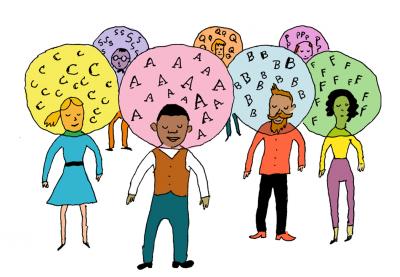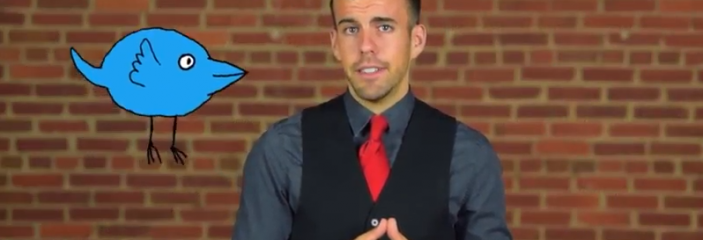Learn the language that can help you—and your students—decode the complexities of the digital-media landscape. This vocabulary list covers the many ways “fake news” finds its way online, highlights key terms necessary to understand media manipulation, and describes how our brains absorb information—and how they can steer us away from the truth.
As our story “What Is the ‘Alt-Right’?” reveals, the internet can be a gateway to hate, particularly for young people who don’t know how to critically evaluate sources. This list is part of Teaching Tolerance’s new digital literacy project, an initiative to help educators bring these concepts into the classroom and equip students to guard against hate and bias online.
Agnotology: The study of ignorance.
Algorithm: A procedure used to locate specific data within a collection of information. Also called a “search algorithm.”
Apophenia: The tendency to perceive meaningful connections in unrelated things; seeing patterns where none exist.
Astroturfing: The practice of concealing the financial stakeholders promoting a message or an organization so that it seems to come from and be supported by grassroots entities.
Belief perseverance: The tendency to continue believing something even after learning that the foundation of the belief is false.
Bot: An automated online program; short for web robot.
Chan culture: Beliefs and activities related to online message boards such as 4chan and 8chan, where often-offensive images and memes are created and distributed.
Clickbait: Online content created with the primary purpose of attracting visitors and enticing them to click on a link to a specific web page.
Confirmation bias: The tendency to process new information as confirmation of the beliefs one already holds.
Cognitive bias: A mental-processing error (e.g., in reasoning, interpreting or remembering) that often results from clinging to preferences and beliefs in spite of contrary evidence.
Computational propaganda: The manipulation of information and communication technologies to influence attitudes, thinking processes and behavior.
Copypasta: A block of online text that has been copied and pasted from somewhere else.
Counterknowledge: Inaccurate information that is presented as fact and is believed by a critical mass of people.
Crowdsourcing: The practice of acquiring information for or contributions to a project by seeking the aid of a large number of people, usually via the internet.
Digital footprint: The information about a person that can be found online as a result of their internet activity.
Digital native: A person born or raised during the digital age and who is assumed to be familiar with the internet, computers and other digital technology from an early age.
Disinformation: False information that is disseminated to the media or other entities with the purpose of deceiving.
Dox: To publicly share private or identifying information about a person online, usually with a malicious or vengeful purpose.
Dunning-Kruger effect: A cognitive bias that leads people of limited skills or knowledge to mistakenly believe their abilities are greater than they actually are.
Fake news: Disinformation that is presented as news and optimized for online sharing.
Filter bubble: The limited perspective that can result from personalized search algorithms.
Group polarization: A group’s tendency to make more extreme decisions than its individual members would typically be inclined to make.
Groupthink: A group’s practice of thinking or making decisions in such a way that promotes harmony and conformity within the group at the expense of creativity or individual responsibility.
Heuristic: A cognitive shortcut, rule or method that helps people solve problems in less time than it would take to think the problem all the way through.
Homophily: The tendency to form connections with people who are similar to oneself.
Illusion of comprehension: A cognitive bias that occurs when people mistake familiarity or awareness for understanding. Also called the “familiarity effect.”
Information cascade: A phenomenon in which people echo the opinions of others, usually online, even when their own opinions or exposure to information contradicts that opinion. When information cascades form a pattern, this pattern can begin to overpower later opinions by making it seem as if a consensus already exists.
Information diet: The kinds and quantity of information that a person consumes on a regular basis.
Information literacy: The ability to recognize the need for information and to locate, analyze and use it effectively in a variety of ways.
Information pollution: The tainting of available information with inaccuracy, redundancy and lack of quality.
Infotainment: Material, online or otherwise, that combines information with entertainment. Often used to describe material ostensibly intended to inform but which is primarily designed for entertainment.
Lulz: Laughter and enjoyment, usually at someone else’s expense.
Media hacking: The manipulation of electronic and online media, especially social media, to shape a particular narrative.
Meme: An image, video, phrase, symbol or other piece of culture that is meant to be funny and is shared widely via the internet, often with slight changes.
Memejacking: The act of hijacking a meme and using it for purposes different from those of its original authors.
Motivated reasoning: The tendency to process new information in such a way that it will fit with previously held beliefs.
Myside bias: The tendency to endorse information that supports one’s previously held beliefs, truth notwithstanding.
Native advertising: Online advertising that fluidly adheres to the look and feel of the context or platform in which it is placed.
Opinion laundering: The practice of making opinions seem more valid by representing them as coming from think tanks or other sources that seem reliable. See Astroturfing.
Poe’s law: Taken from a comment made by an online forum participant, Nathan Poe, the idea that it is nearly impossible to distinguish between an extremist view and a parody of it without clear evidence of the author’s purpose.
Social spam: Unwanted material that shows up on social networking platforms and any website with content generated by users.
Sock puppet: An online user posing as another person—often a real person—usually to express their own views anonymously.
Sponsored content: An advertiser’s paid content in an online publication that takes on the look and qualities of that publisher’s editorial content.
Stealth marketing: The practice of paying people to promote products without revealing that those people are being compensated.
Troll: A person who engages in provocative or harassing online behavior using their real identity. Distinct from a Bot or a Sock puppet.
Two-sides fallacy: The presentation of an issue that makes it seem to have two sides of equal weight or significance, when in fact a consensus or much stronger argument supports just one side. Also called “false balance” or “false equivalence.”




0 COMMENTS